Peru is among the world’s most biodiverse countries. More than 1,730 bird species have been recorded—second only to Colombia. Stretching from the Pacific coastal deserts across the Andes to the Amazon rainforest, Peru’s dramatic gradients in climate and terrain create a mosaic of habitats that support an exceptional array of wildlife. Numerous protected areas safeguard these species, though many now face mounting threats.
Below is a curated, publication-ready guide to 45+ native Peruvian animals—their common and scientific names, standout traits, and habitat notes.

Camelids: llama, alpaca, vicuña & guanaco
Guinea pig (“cuy”)
Andean cock-of-the-rock (national bird)
Andean condor
Green anaconda
More native Peruvian animals
Birds
Mammals
Reptiles
Fishes
Native Peruvian animals at risk (by group)
All four belong to Camelidae and are emblematic across the Peruvian highlands, yet they differ in size, fiber, and domestication.
Llama (Lama glama)
The best-known Andean companion animal. Alert and prone to spitting when threatened, llamas are widely used for pack transport—travelers often encounter them around sites like Machu Picchu.
Alpaca (Vicugna pacos)
Smaller than llamas and fully domesticated for luxury fiber. Dense, soft fleece makes alpacas cornerstones of Andean textile traditions.
Vicuña (Vicugna vicugna)
The smallest of the four. A wild, high-elevation species producing ultra-fine fiber; historically protected and carefully managed due to its high value.
Guanaco (Lama guanicoe)
The wild counterpart to llamas and alpacas—not domesticated. Rust-brown coat, highly resilient, ranging across puna and montane grasslands.
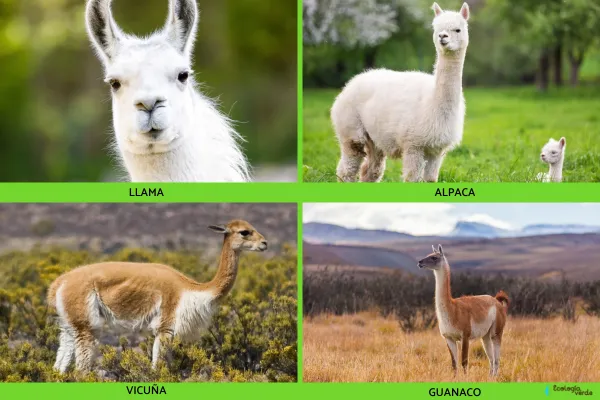
Quick ID tip: look at size & fleece (alpaca dense and soft, vicuña even finer; guanaco shorter coat; llama tallest), and domestication (llama/alpaca are domestic; vicuña/guanaco are wild).
Scientific name: Cavia porcellus
Snapshot: A domesticated Andean rodent, locally called cuy. Social and gentle, typically up to ~1 kg, with a lifespan of 5–8 years. Now common worldwide as a companion animal, but its origins lie in Peru and neighboring Andean regions.
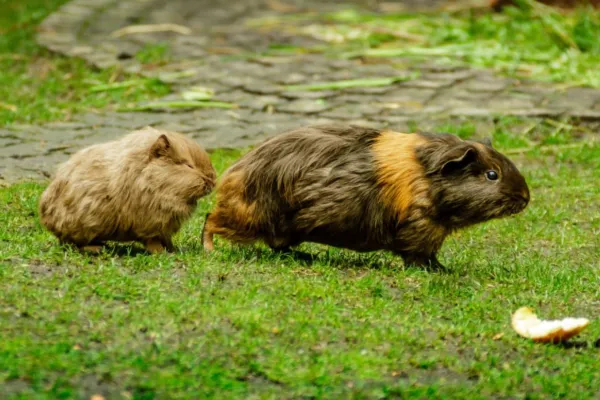
Scientific name: Rupicola peruvianus
Snapshot: Peru’s national bird, known in Quechua as “tunki.” Males sport a flamboyant semi-circular crest and vivid orange-to-scarlet plumage, gathering at leks for group courtship displays. Found in cloud forests along the Andean–Amazonian transition; primarily frugivorous and key to seed dispersal.
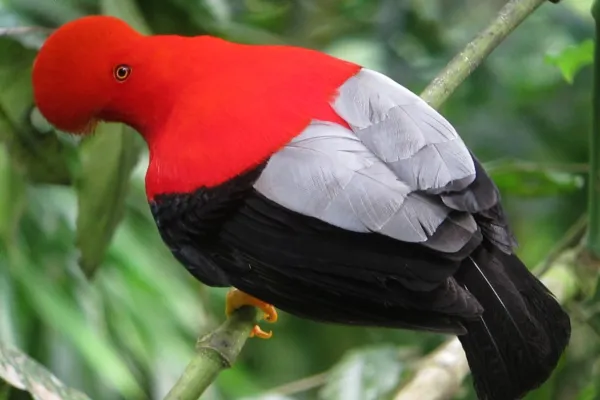
Scientific name: Vultur gryphus
Snapshot: A high-Andes icon and master scavenger with a wingspan exceeding 3.2 m. Often soars on cliffside updrafts over canyons and escarpments. Vital to ecosystem sanitation in mountain environments.
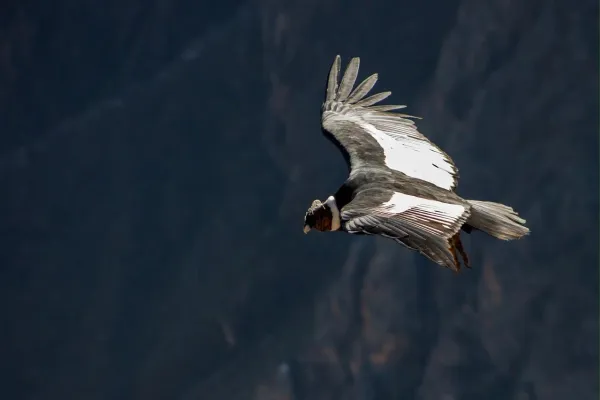
Scientific name: Eunectes murinus
Snapshot: One of the heaviest snakes on Earth, thriving in lowland Amazon wetlands of Peru. An adept swimmer and powerful constrictor, capable of subduing prey from fish and birds to capybaras and caimans; can unhinge jaws to swallow large prey.

Humboldt Penguin (Spheniscus humboldti)
Breeds on coastal cliffs and islands influenced by the Humboldt Current—a flagship species of Peru’s cold, nutrient-rich waters.
Peruvian Pelican (Pelecanus thagus)
A large coastal species; watch for coordinated plunge-diving flocks along the shore.
Parrots (Family Psittacidae)
Widespread from lowland rainforest to foothills; several species are impacted by illegal pet trade and nest-tree loss.
Emerald Toucanet (Aulacorhynchus prasinus)
A green canopy frugivore with a colorful bill; common in montane forests.
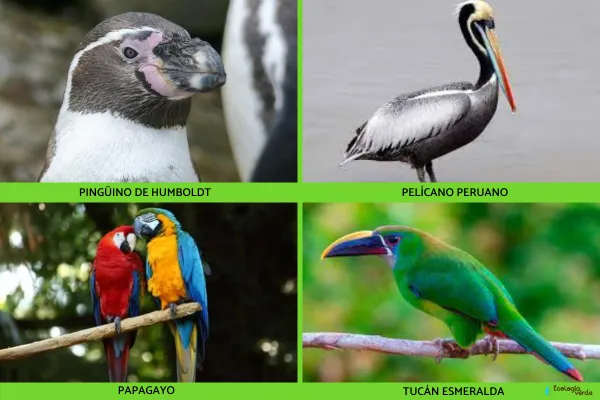
Puma (Puma concolor)
A wide-ranging apex predator occurring from coastal deserts to high-Andean grasslands.
Northern Mountain Viscacha (Lagidium peruanum)
The Andean “rock-rabbit”—day-active, agile cliff-jumper of rocky slopes.
Peruvian Hairless Dog (Canis familiaris, heritage breed)
An ancient local breed, nearly hairless, culturally significant along coast and highlands.
“Sajino/chancho” (local terms)
In common usage “sajino” often refers to the collared peccary (Pecari tajacu). The term “chancho” can be used broadly and may also mean domestic pig (Sus scrofa domestica) in local contexts—be mindful of this naming overlap.
South American Sea Lion (Otaria flavescens)
A coastal mainstay forming large breeding colonies on beaches and rocky islands.
Vampire bats (Subfamily Desmodontinae)
Specialized hematophagous bats; important subjects in disease ecology and wildlife–livestock interface studies.
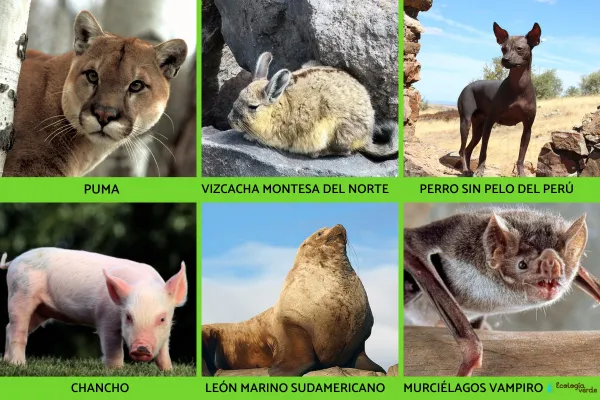
Eyelash Palm-Pitviper (Bothriechis schlegelii)
Arboreal, highly venomous, with distinctive “eyelash” scales; inhabits rain and cloud forests.
Fire Skink (Riopa fernandi)
Brightly colored, semi-fossorial skink; the name “Peru skink” may appear in trade, but verify locality.
Lima Leaf-toed Gecko (Phyllodactylus sentosus)
A gecko native to the Lima region; urban expansion and habitat fragmentation are key threats.
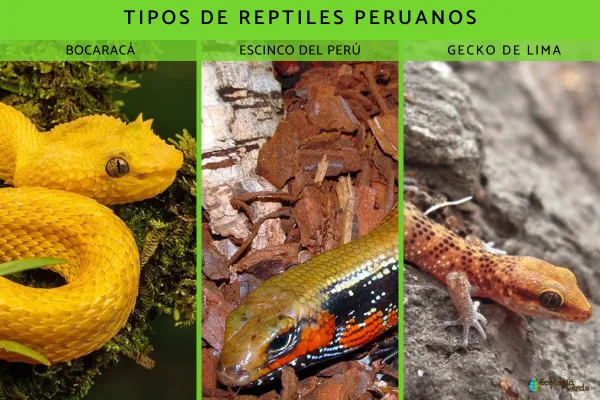
Arapaima (Paiche) (Arapaima gigas)
A freshwater giant of the Amazon basin; surfaces to breathe air and is culturally and economically important.
Catfishes (Order Siluriformes)
Diverse in rivers, estuaries, and nearshore waters; many are staple fisheries.
Black Scabbardfish (Aphanopus carbo)
A deep-sea, ribbon-shaped predator recorded off Peru’s outer shelf/slope.
Piranhas (Family Serrasalmidae)
Iconic Amazon fishes with serrated teeth; many are opportunistic rather than indiscriminate attackers.
Striped Jawfish (Opistognathus randalli)
Burrow-dweller that “peeks” from sandy holes; notable mouthbrooders among jawfishes.
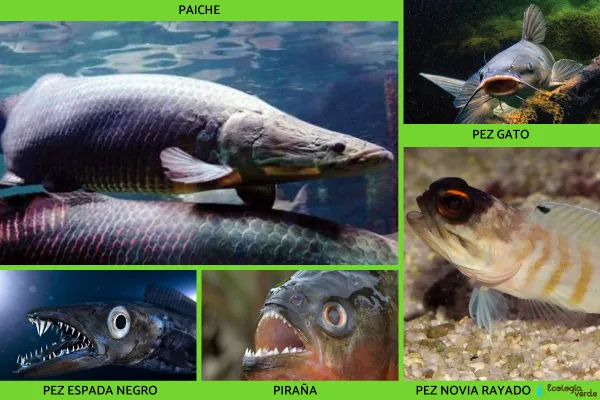
Andean Night Monkey (Aotus miconax)
Andean titi/“squirrel monkey” (local usage) Saimiri sciureus (naming varies locally)
Spectacled Bear (Andean Bear) Tremarctos ornatus
Goeldi’s Monkey Callimico goeldii
Bald Uakari Cacajao calvus
Yellow-tailed Woolly Monkey Oreonax flavicauda
Andean Cat Leopardus jacobita
Oncilla (Little Spotted Cat) Leopardus tigrinus
Jaguar Panthera onca
Giant Anteater Myrmecophaga tridactyla
Northern Pudu Pudu mephistophiles
Amazon River Dolphin (Pink River Dolphin) Inia geoffrensis
Mountain Tapir Tapirus pinchaque
Giant Armadillo Priodontes maximus
Long-tailed Chinchilla Chinchilla lanigera
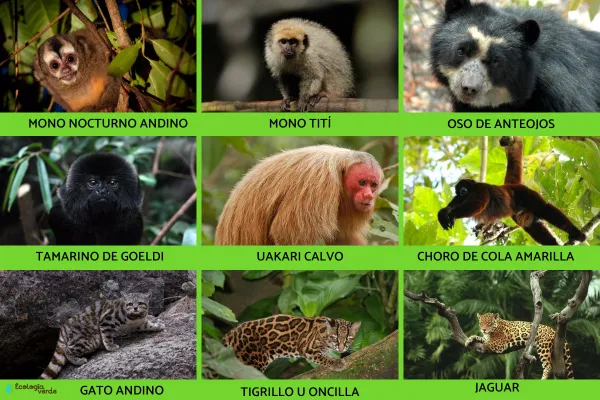

Amazon Parakeet Nannopsittaca dachilleae
Military Macaw Ara militaris
Gentry’s Antwren (Tiluchí antiguo) Herpsilochmus gentryi
Andean Marsupial Frog Gastrotheca riobambae
Ancash Water Frog Telmatobius ventriflavum
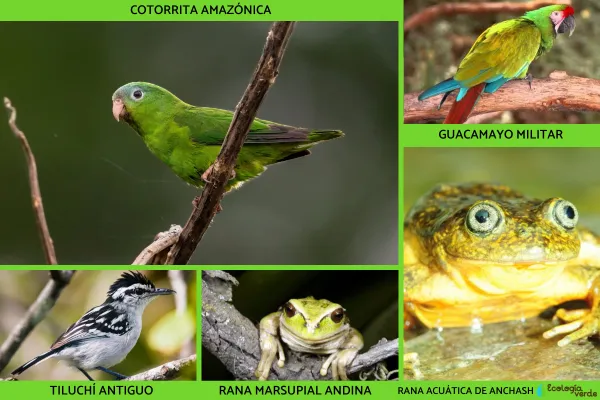
Note: Common names and local “folk names” can vary by region; scientific names are provided for clarity and further lookup.
From the high-Andean camelids and the cloud-forest cock-of-the-rock, to the coastal Humboldt penguin, Amazonian paiche and green anaconda, Peru’s coast–mountain–rainforest continuum forms a living ladder of habitats. Protecting these species means safeguarding habitat continuity across that ladder—ensuring that Peru’s extraordinary wildlife endures.
Bibliography
Saldaña, J. S. & Saldaña, V. Z. (2011). Hunting wild animals in the community of Bretaña, Puinahua River, Loreto (Peru). Colombian Journal of Animal Science (RECIA), Volume 3 (2), pp: 225–237.
Gerken, M. (2008). South American Camelids Research. The Netherlands: Wageningen Academic, pp: 375–386.
Montesinos, I.; Catachura, A.; Sánchez, J. & Franco, J. L. (2015). Characterization of sheep on the southern coast of Peru. Cambridge University Press, Volume 56, pp: 55–62.
Quintana, H. & Pacheco, V. (2007). Identification and distribution of vampire bats in Peru. Peruvian Journal of Experimental Medicine and Public Health, Volume 24 (1).
animal tags: animals peru
We created this article in conjunction with AI technology, then made sure it was fact-checked and edited by a Animals Top editor.